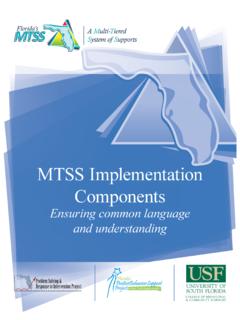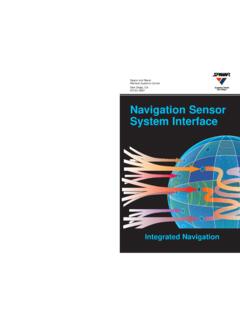Transcription of CROSSWALK: FLORIDA PRINCIPAL LEADERSHIP …
1 crosswalk : FLORIDA PRINCIPAL LEADERSHIP standards ( fpls ) 2011 AND 2005 2011 standards GENERAL DEVELOPMENT ISSUES 2005 standards Method of Development Both the 2005 and 2011 standards were developed by a collaborative statewide process involving a broad cross-section of stakeholders and extensive opportunities for public review and input over a 6 month period. 2005 fpls was informed by historical patterns of what principals jobs entailed. 2011 fpls was informed by gap analyses by national experts comparing issues in the 2005 standards to contemporary research on effective school LEADERSHIP practices and practitioners input on high impact LEADERSHIP behaviors.
2 2011 fpls are modeled after the 2010 revised FEAPs and adds clarifying and defining descriptors to address gaps in the 2005 standards and focus on priorities for LEADERSHIP curricula and proficiency assessments. Infusion of 2005 fpls into 2011 fpls The issues addressed in the 2005 fpls are infused in various ways into the 2011 fpls : Eight of the 2005 fpls are fully merged into the 2011 fpls and modified with more specific language based on contemporary research and current state priorities. Various learning environment issues scattered among several 2005 standards and the 2005 Diversity Standard merged into a single more research based 2011 Learning Environment standard to create actionable and observable expectations.
3 Technology and Vision standards from 2005 were addressed in the descriptors of other 2011 standards reflecting statewide progress on these areas since 2005 Reorganized standards While informed by and incorporating the 2005 fpls issues, the 2011 fpls were formulated based on contemporary research on factors that characterize effective school leaders. Many standards were re-titled to reflect research findings, current state educational priorities and upgraded expectations for PRINCIPAL proficiency. The use of domains and descriptors clarifies the foundational purposes of the 2011 fpls .
4 New standards The 2011 fpls adds new standards to address gaps between the 2005 fpls and contemporary research on effective school LEADERSHIP . Student Results Student Learning as a Priority LEADERSHIP Development Text from the 2011 standards ANALYSIS: Alignment and Differences between versions Text from the 2005 standards Addresses the effective school leader Focus Levels The 2005 fpls addressed high performing leaders . In 2005, PRINCIPAL evaluation system ratings were limited to satisfactory or unsatisfactory so no practical linkage existed between the concept of high performing and actual evaluations.
5 The 2011 fpls speak to effective school leaders linking the application of the standards to the state s mandatory summative ratings (highly effective, effective, needs improvement, unsatisfactory). Descriptors clarify the research based practices targeted and the proficiency expectations sought through the standards . Addresses high performing leaders Contains 10 standards organized into 4 Domains: Student Achievement Instructional LEADERSHIP Organizational LEADERSHIP Professional and Ethical Behavior Organization and Presentation Format 2005: Ten standards organized into three broad categories based on then current views on job requirements of the PRINCIPAL 2011: Ten standards organized by four domains , linking the standards to the domain organizational concept used in evaluation systems across the state.
6 2011 Standard 1: Student Learning Results was intentionally listed as the first standard to reflect the significance of student learning. The order of the rest of the 2011 standards is based on grouping related issues and does not imply relative importance. The 2011 fpls is modeled after the 2010 revised FEAPs and adds descriptors to clarify expectations and focus on proficiency issues revealed by research to support the state s educational LEADERSHIP goals. Contains 10 standards organized into 3 categories: Instructional LEADERSHIP Operational LEADERSHIP School LEADERSHIP Purpose: The standards are set forth in rule as FLORIDA s core expectations for effective school administrators.
7 The standards are based on contemporary research on multi-dimensional school LEADERSHIP , and represent skill sets and knowledge bases needed in effective schools. The standards form the foundation for school leader personnel evaluations and professional development systems, school LEADERSHIP preparation programs, and educator certification requirements. Purposes 2005 fpls , evolved from the 19 PRINCIPAL Competencies of 1985, are a job description based approach focused on job requirements and delegated authority . An introductory paragraph addressed abilities and skills a school leader must possess.
8 2011 fpls is focused on LEADERSHIP practices revealed by contemporary research to impact the quality of student learning and faculty proficiency, acknowledges the multi-dimensional nature of effective school LEADERSHIP , and addresses core expectations for effective school administrators. 2011 fpls explicitly connect the standards to school leader personnel evaluations, professional development systems, school LEADERSHIP preparation programs, and educator certification requirements. FLORIDA s school leaders must possess the abilities and skills necessary to perform their designated tasks in a high-performing manner.
9 The school leader, commensurate with job requirements and delegated authority, shall demonstrate competence in the following standards : Structure: There are ten standards grouped into categories, which can be considered domains of effective LEADERSHIP . Each Standard has a title and includes, as necessary, descriptors that further clarify or define the Standard, so that the standards may be developed further into LEADERSHIP Structure Both 2005 and 2011 fpls present 10 standards 2011 fpls addition of domains and descriptors that further clarify or define each standard (so that the standards may be developed further into LEADERSHIP curricula and proficiency assessments in fulfillment of their purposes)
10 Provides clearer links to contemporary research on effective LEADERSHIP practices than did the 2005 fpls . No reference to structure curricula and proficiency assessments in fulfillment of their purposes Standard 1: Student Learning ResultsEffective school leaders achieve results on the school s student learning goals.. a. The school s learning goals are based on the state s adopted student academic standards and the district s adopted curricula; and b. Student learning results are evidenced by the student performance and growth on statewide assessments; district-determined assessments that are implemented by the district under Section , ; international assessments; and other indicators of student success adopted by the district and state.





